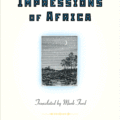“The rope that keeps me from floundering”: On Michel Leiris

First exhibited at the 1865 Paris Salon, Olympia by Édouard Manet, was immediately greeted with shock and outrage. The response was so virulent that, as contemporary journalist Antonin Proust later recalled: “If the canvas of the Olympia was not destroyed, it is only because of the precautions that were taken by the administration.”
The painting has a number of obvious precedents—Giorgione’s Dresden Venus or Titian’s Venus of Orbino, for instance—but this reclining nude woman accompanied by a black chambermaid who has brought her a bouquet of flowers, is no idealized goddess. Rather, her cool, confrontational stare and the ornamentation she wears, including bracelet, pearl earrings, pink bow or flower in her hair, and black ribbon at her neck, along with the black cat on the foot of her bed, even her name, all indicate that she is a prostitute—and a confident, self-assured one at that.
Faced with a work so unconventional in style, with its boldly lit, stark realism and morally questionable content, critics and the public alike were united in their condemnation. Of course, it is now counted among Manet’s masterpieces.
In the late 1970s, more than a hundred years after Olympia made her debut, French writer and ethnographer Michel Leiris (1901 – 1990) adopted the enigmatic young woman as his muse and made her the centerpiece—or perhaps justification—for a continued exploration of aging and death, themes that had long dominated his literary pursuits.
Well-known and highly respected in his homeland, albeit remarkably modest about his accomplishments, Leiris already had, by this time, an impressive body of work including poetry, critical essays, anthropological research, and an important series of memoirs to his credit. The Ribbon at Olympia’s Throat (Le ruban au cou d’Olympia, 1981) would be his last major work. With the recent publication by Semiotext(e), in a fluid translation by Christine Pichini, English language audiences finally have an opportunity to experience this eclectic meditation on art, writing, and the elusive notion of modernity.
Tying it all together if you will, is the slim black ribbon that entrances and obsesses Leiris and holds, he believes, an important key to something he has yet to fully understand.
Outside of his formal ethnographic and critical writing, the subject that fascinated Michel Leiris the most was his own self. He was exceptionally introspective and, as such, over the course of his lifetime he pioneered a deeply personal, reflective, autobiographical style of writing, one that he envisioned as an essential literature in its own right—a perspective first articulated in his essay, “The Autobiographer as Torero” (appended to the 1946 re-issue of his first confessional work, Manhood) wherein he draws a comparison between the autobiographical author and the matador. Both must put their lives, or truths, on the line; they survive by engaging in an exercise that is dramatic, authentic, and elegant; both accept risk, albeit one moral and the other, flesh and blood.
With a life that spanned the better part of the twentieth century, Leiris was one of the most versatile and influential intellectuals of his day. His social and artistic circle encompassed a wide array of important and innovative artists, literary and intellectual figures including Georges Bataille, Raymond Queneau, Picasso, Apollinaire, Albert Giacometti, Aimé Césaire and many more. His friends and personal acquaintances often became his critical subjects, lending a tone of casual intimacy and respect to his essays and commentaries on their lives and work. These denizens of Parisian society also frequented his nocturnal adventures, granting a who’s-who quality to the strangely detailed accounts of the dream and dream-like experiences that he recorded throughout his life.
From an early age, Leiris was drawn to language and writing. He launched his own literary career in the 1920s as a Surrealist poet, associated with André Breton and his cohorts, but by the end of that decade, he had grown disillusioned with the movement. He left to join his friend Georges Bataille as an editor for Bataille’s journal, Documents. There he met noted anthropologist Marcel Griaule, who invited the young writer to join him as secretary-archivist on an ambitious expedition across North Africa, from Dakar to Djibouti.
At the time, Leiris was recovering from an episode of depression. His psychoanalyst felt a change of environment would be healthy. But Leiris had several other personal motivations. He admitted to a bit of a romantic infatuation with the idea of black Africa, nurtured in the jazz clubs of Paris, but more critically, he hoped that such an experience would help him better understand himself.[i] Looking back almost two decades later he would confess:
If at one time in my life I embarked on a long and presumably difficult voyage from which, yielding romantically to the itch for the exotic, I expected everything, this was the outcome of an eternal evolution in which cultural elements also figured: a reading of Lévy-Bruhl that awakened my curiosity about the “primitive mind,” an interest in Negro art (like so many people of my generation, whose disgust with classical art also led them to children’s drawings, folk art, and the art of mad people), an admiration for the poetry of Rimbaud, and even more for his person, aureoled with the silence he drew from the quarries of Cyprus and the barbarism of Ethiopia. [ii]
The extensive journal he maintained throughout the course of the two year-long journey, Phantom Africa (L’ Afrique fantôme, 1934) would stand as his first major work—his initial foray into ethnographic research, a career that he would pursue for the rest of his life, and his first engagement with a characteristic form of autobiographical writing that he would proceed to flesh out and expand over the course of his writing career.
Leiris was a prolific, productive writer who wrote extensively in a wide variety of genres. His work at the Musée de L’Homme exposed him to the lives and concerns of cultures and communities emerging from periods of colonial exploitation and control, and as someone whose personal milieu was filled with musical, artistic, and intellectual richness, he struggled to reconcile his literary and his socio-political commitments. He took part in a mission to Côte d’Ivoire in 1937, became involved with concerns championed by Sartre as part of the editorial team of the philosopher’s Les temps moderne, and when China opened its doors to foreigners in the 1950s, Leiris was drawn, like many other similarly infatuated French luminaries, to visit with the intention of correcting Western misconceptions about the Communist regime.
The Ribbon at Olympia’s Throat falls into the natural, if not preconceived, trajectory of his autobiographical writing. Manhood (L’Age d’Homme, 1939), one his most widely read works, marks his first formal expedition into the terrain of his own personal experience, traversing the full range of his sexual fantasies and obsessions on the road from boyhood to manhood. The subject matter is harsh, offensive—though with Leiris it is typically the thought rather than the deed that shocks—the writing executed with a precise, carefully mediated hand. With Scratches (Biffures, 1948), the first installment of what would become a four-part autobiography, Rules of the Game (Le Règle du Jeu), he embarks on an explicit mission to understand what sort of man he is, to identify, clarify, and articulate the way that he sees himself fitting into the world. His primary concern is essentially existential: he wants to know not only what he thinks, but how he thinks and how he can best communicate his thoughts.
Thus this was, and would continue to be, an internally driven process, one in which he sets loose his writing style, giving himself free rein to open up and flow forth in sentences that often wind across half a page or more but never seem to get lost. Language itself—words, sounds, meanings—is not only Leiris’ medium, it is the metaphysical course his reasoning follows. He is avowedly a self-conscious writer, relying on a system of confident uncertainty, a belief in the search, routinely circling back to revisit memories, dreams, and experiences in overlapping, digressive tangents before zeroing in on the essence of what he hopes to express.
He will often start with a question, a remembered experience, a piece of music, or even an expression, such as “curtains of clouds.” From there it is as if he sets off on a journey filled with childhood remembrances, recent encounters, literary observations, musings and other diverse wanderings. Although he has a certain timeframe or direction in mind, it is in the getting “there,” wherever that may be, that he discovers what his real concerns are.
A sequel to Scratches, called Scraps (Foubris) followed in 1955. Translator Lydia Davis notes that by the end of this second volume Leiris seems to indicate that the project was complete. Yet a third installment, Fibrilles, appeared in 1966 (released in English as Fibrils in 2018). Here the central subject is Leiris’s account of an extramarital affair, the intense guilt it caused him, and his subsequent suicide attempt. He is also acutely aware of the act of writing itself, the notes he keeps, and the bits and pieces that go into the process of collecting the thoughts, feelings, and memories that become part of the essay that is taking shape beneath his pen.
The fourth and final volume, Frêle Bruit, appeared in 1976. According to Davis, this longer work, which is not yet available in English, lacks the distinctive chronological or logical framework of the earlier parts. It pulls together threads drawn from throughout his life, and unlike the earlier installments, which feature continuous dense sections with few breaks, this text is divided into multiple short passages. Written in his mid-seventies—officially an old man—aging and the horror of his own mortality occupy more of his attention than ever. These are not new concerns, they have troubled him for as long as he has been capturing his impressions and self-assessments on paper (toward the end of Phantom Africa, published more than forty years earlier, he was already despairing about how little he had accomplished in life). By this point, after four volumes, he comes to a major conclusion about himself, an awareness of “a perverse inclination to find enjoyment only in ambiguity and paradox.”
Olympia gives the same impression. But with its short anecdotes, brief essayistic pieces, list-like poems, exercises in wordplay and dream accounts, and the loosely unifying obsession with the black ribbon in Manet’s painting, the volume is best understood as a separate but related work.
The book opens with an episode of vertigo—the bed lurching wildly—that occasions a brief reflection on what this incident indicates for his health and advancing age. Leiris is unable to even get through the first page without glancing at the spectre of death. As ever, that fear will remain close. However, in the next section (or fragment since that is a better, if not solely accurate description), he engages his reader in a friendly one-sided conversation, playfully satirizing his own writerly pretensions. Thinking about the act of remembering sometimes seems more important that the actual memory itself. This swings back to reinforce his anxieties about aging.
Leiris took a lifetime interest in his own dream-life and that liminal space between sleep and wakefulness, dating back to his twenties (a dream diary, Nights as Day, Days as Nights, was published in 1961). In Olympia, these sections take on a slightly different tone. The dreams he remembers are reported and dissected, but he is not simply content to recount what stays with him. From this vantage point in life he seems more interested in trying to determine what real or imagined event or place may have provided a template for the dream.
There is now a more explicitly retrospective quality, indicative of an aged man taking inventory of his nocturnal wanderings in relation to a catalogue of past experiences. And as before, famous friends occasionally make an appearance in that strange and distorted way people we know sometimes invade our dream worlds.
Manet’s painting is first mentioned in an early, italicized meditation on artworks that, by virtue of an unexpected element, transcend time. Leiris takes special notice of the ribbon cinched low across her throat and the mules she wears, how the one on her right foot has slipped off. These touches make her appear more naked, in Leiris’s mind, and offer a disarming element of modernity, a sharp counterpoint to her mythological namesake, in that same way that the watch-bracelets worn by Picasso’s nudes, or the hypodermic needle in the arm of Francis Bacon’s reclining nude render their images more immediate, becoming “the detail we touch with our fingers, bait we sink our teeth into, that makes Saint Thomases of us.”
Leiris speculates he was probably quite young when he first became aware of Olympia’s existence. In accord with the original public visceral response to the work, his own family opinions differed, and that was, he reasons, likely part of the spell she cast on him:
Isn’t it because of the echoes of the disagreement she caused so long ago between my father, the philistine, and his relative by marriage, the refined connoisseur, that to me she remains clad in the singular charm of the famous but often misunderstood work that, passionately contested and regarded by some as a sin against good taste, is imbued—despite so much incense—with a slight whiff of heresy?
Of course, she is an ideal subject for the late-life reflections of a man whose work has, at least in his own assessment, so often circled around matters of sexual fixation. His admitted sexual insecurities appear as early as Phantom Africa where he recounts his fantasies and wonders at his own inability to exercise the sexual liberties his teammates on the expedition so eagerly indulged in. In his old age sexual insecurity continues to haunt—and obsess—him.
He describes a recent episode where he was propositioned by women on the street. Clearly flattered, he declines, describing himself as too old, but he cannot put the experience, or the what-if’s behind him. More than forty years after his first travels across Africa, where he openly allowed anxieties about sexual inadequacy to slide into his journal, Leiris is still measuring his virility and finding himself sadly wanting. Given his natural tendency to be self-deprecating in his self-assessments, it would be interesting to see how he might have responded to the present discussions about the role masculinity plays in modern society.
He recognizes the dramatic and subversive elements in the painting, calling attention to a contemporary, almost worldly, young woman who can be viewed from two angles: the salacious, as “clearly a venal girl, and more real because of it,” and the luxurious, as “an ornament with no soul other than her charm, a girl-puppet as white and cold as her name suggests.” He wonders at Manet’s possible intent, marveling at the way his Olympia is “arranged like the stems of the sumptuous bouquet of carnal love gathered together in the cramped room that provides its setting.”
At the center, the object of desire, with the few ornaments that only serve to enhance her nudity, “the call to passions foreign” represented by her dark-skinned chambermaid, and the “obscurity of a mystery that allows itself to be touched but cannot be diminished by a caress (the black cat).” But it is the ribbon around Olympia’s pale white throat that holds him in thrall. The ultimate goal of his project, its raison d’etre if it needs one, is to figure out why.
However, this is Michel Leiris. No digressive venture, no matter how varied, or seemingly disconnected the stops along the way, is a journey without an ultimate destination. He is slowly crafting a structured investigation—or at least that is the effect of the ordering, editing, and placement of the segments that form the final course of the text. His aim is to find another piece of the answer to yet another variation on the question that has plagued him throughout his life: What kind of a man am I?
Now, with that familiar spectre of mortality looming ever closer, thought begets counterthought. He moves back and forth across ideas as he checks and re-checks his emotional and logical processes. The path is strewn with seemingly tangential asides before it returns to some kind of resolution, often an uneasy one. The fragmented form of Olympia exaggerates the dynamic quality of his reasoning.
Given his introspective inclinations and skeptical, anxious nature, all he has are his own memories, dreams, and observations to guide him. He can never trust them until he locates the language and imagery necessary to secure them on the page.
However, the self is a moving target, and with his worries about the increasing ephemerality of his mortal existence, he feels even less confident in the efficacy of his tools. Many of the longer essay sections in The Ribbon at Olympia’s Throat explore this classic Leiris territory—writing, inspiration, and existence. It’s a subject only his own death will silence—and even then one might argue that, on this topic, his apprehensions will continue to resonate with writers for as long as writers exist. He obsesses over the act, over the search for exactly the right words, the appropriate tense, and tone.
Writing is an essential activity—if he is not writing he experiences a feeling akin to withdrawal—and even after a long career, the fear of failure still rides him. But he is not writing himself into the outside world, the existential equation one might expect. Rather, as he puts it, he is “concentrating the external world inside myself.” And no one is quite as passionate about the intensity and inherent anxiety that drives such a creative process; he frets and agonizes over every aspect only, in the end, to be uncertain if he has achieved anything of worth at all:
Engaging in language in any respect, I have every right to be anxious, for I perhaps play too fast and loose with it and am not completely sure it will hold. And yet, I know this irritating conviction by experience and return to it: the sense that I am the guilty party (as much as if I had floundered horribly through a delicate situation, sinned against good taste, made a serious gaffe, foolishly missed an opportunity, all things we often wring our hands over) grips me when I don’t write or when I think that I am writing badly, that publishing the awful thing would certainly expose me to the cruelest of verdicts—What a loser!
He writes, awash in the risk of failure, to assure himself that he is alive, to stave off death. With such an insatiable need, Olympia, incorporating as it does themes and forms that have slipped in and out of his writing from his earliest days dabbling in Surrealist poetry, builds upon a lifelong project of writing to make sense of his own thoughts and ways of thinking.
Whether Manet intended the ribbon as more than an aesthetic feature, Leiris recognizes it as the “unnecessary detail that hooks us and makes Olympia real. Just like the object that, a foreign body joined to a living body whose presence it reinforces, gives the fetishist a hard-on.” But the ribbon seems to represent more than a sexual fetish object. The length of black silk is presented, over the course of this book, as a talisman, and a charm, as well as a thing to which a near-excessive devotion is displayed—that is, a fetish in very sense of the word. It also presents another element Leiris finds at least equally irresistible: a paradox.
This same black silk ribbon that renders Olympia more “real,” does so by making her appear modern. But what is the meaning of this modernity?
Curious as you might be about everything that is being done or written about or said, there always come a point—if you live long enough—when you feel you no longer belong to your own time. Before, you were in it, or at least you had the illusion that you were. Now you find that, in the domain that still might be considered your own, many things probably worthy of attention are being produced without you, and sometimes without your even being able to understand them… To no longer belong to one’s time is to no longer be a part of life; it is to be already a part of death.
“Modern” is a slippery and fluid concept, easily slipping into the realm of “retro” or “quaint.” What is it, then, that bestows a perpetual sense of modernity on an artwork more than a hundred years after its execution? What essence does that slim ribbon contain? Does it somehow tie an image from the past to the present, granting it a timelessness, a modernity that fails to fade and becomes instead eternal?
Leiris considers this conundrum, then decides that to be truly modern is to speak not to the present age but to speak outside of it.
So what does he ultimately find in this representation of the reclining, ribbon-clad nude that transcends the present? In his attempt to offer a final interpretation of Olympia he returns to memories of his first encounter with Richard Strauss’s macabre opera Salomé, followed by a series of fragments and anecdotes that draw on images of anxiety and violence, oftenalluding to the ribbon as symbolic of a ligature or a means of hiding a wound. However, allowing the power of the fetish to guide his rationalization produces a less than satisfying exploration. Leiris seems to be aware of this. Toward the end, he worries and frets about whether he will even live long enough to finish the book at hand and come to understand the true hold of this length of black silk.
As he pushes on, the threads of his inquiry are pulled together into a discourse that, still fragmented, moves forward with a gathering intensity. The problem, we begin to sense, is that the parameters of investigation are inadequate or misplaced. The world he feels most at a loss to connect with, that increasingly unsettles and unnerves him, is not a literary or artistic one. It is rather one with much deeper roots and a broader context—one that also speaks to his personal political experiences, his professional career as an ethnographer, and his fundamental existence as a human being.
I wish I could say that The Ribbon at Olympia’s Throat ends with a tidy resolution. Questions are raised and left unanswered. Leiris is, as one might expect at this point in his life, engaged in a fair amount of personal reckoning, and there is a strong sense that he is frequently thinking aloud. Whatever the black ribbon might mean, if anything, it provides a guideline to prevent him from losing his way.
However, it is ultimately little more than “a poor spider’s thread” in the face of a much more serious concern. As the closing nears, he refers, without detail, to his increasing alarm at what he hears on the radio. When his wife, his lifelong companion and ballast against his perpetual neuroses, expresses her own anxieties he finds himself even more distressed.
A sombre note
hangs heavy over this book. Its ending resonates uncomfortably with the world
we find ourselves in today. Michel Leiris, a man who lived through two World
Wars, travelled widely, and embraced and became disillusioned with an
intellectual’s Communism, now looks at the news—at the time the Cambodian
genocide would have been front and center—and expresses overwhelming despair at
the stubborn, unyielding persistence of racism and fascism. Plus ça change.
[i] Brent Hayes Edwards, translator, “Introduction to the English Translation,” Phantom Africa by Michel Leiris, Seagull Books, 2017, p. 6 – 7. Leiris also refers to the desire to escape himself and disappointment at his failure to return home “changed” in letters to his wife that are included alongside the text in the Seagull edition of Phantom Africa.
[ii] Michel Leiris, Scratches: Rules of the Game. Volume I (Lydia Davis, trans.) John Hopkins University Press, 1997 (Originally published as Biffures, Paris: Gallimard, 1948.) p. 198.
About Joseph Schreiber
Joseph Schreiber is a writer based in Calgary, Canada. He is the Criticism/Nonfiction Editor at 3:AM Magazine. His reviews, essays and poems have been published in a variety of literary sites and publications including Numéro Cinq, Minor Literature[s], Burning House Press, RIC Journal, and Sultan’s Seal. He also maintains the literary site Roughghosts.





